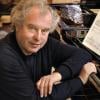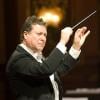
After winning the Chopin International Piano Competition at age 20 and launching an international concert career, what’s the point of going back to school to earn a doctorate degree in aesthetics and philosophy of music? To pianist Rafał Blechacz, who has been visiting San Francisco every year or two since 2008, the investment was perhaps a necessary part of his artistic growth. He appears now as one of those musicians able to infuse concert music with a sense of import and larger issues.
Blechacz appeared on the stage at the Herbst Theatre on April 19 in white tie. He radiated the aura of a bygone era in the old world. With a sense of well-earned authority, Blechacz began with a finely articulated reading of Mozart’s Rondo in A Minor, K. 511. Generous but precise pedalling that followed harmony to elevate the lyrical line showed how Mozart was a serious influence on Chopin’s music. Both share the love of a simple lyrical line above an accompaniment, with playful embellishments and improvisations.

In Mozart’s anguish-filled Sonata in A Minor, K. 310, written around the time of his mother’s death in 1778, there was much evidence of how Mozart also influenced Beethoven, with pounding left hand chords instead of Alberti bass, and the left taking the melody at times. Blechacz unleashed the angst in the dramatic development section, a rather unusual color for Mozart, who wrote just two sonatas in a minor key. The emotional contrast in the Andante movement was delivered with a decisive use of the una corda pedal, that resulted in two, distinct voices.
Fittingly, Beethoven’s Sonata in A Major, Op.101 followed Mozart. Blechacz let the clear, singing melody soar, helped by warm, supportive accompaniment. The dotted rhythm in the second movement was less rigorous, robbing the work of tension and excitement.. The joyous and triumphant fourth movement brought the first half to a close.
In the second half, Schumann’s Sonata No. 2 in G Minor was launched at a blistering pace, with nervous volatility. Blechacz was at home with the stormy movement, but carefully sculpted the rich inner voice in the sweetly lyrical Andante movement. Again, Blechacz’s extraordinary ability to bring out the lyrical line with utmost clarity hinted at greater emotional depths.
The Scherzo, on the other hand, seemed a little drowned by the pedal, with the sharp, dotted-rhythm pattern lost somewhere in the resonant air of the hall. But the nervous tremolos in the final movement articulated the nervous and, at times, neurotic character of the piece.
Blechacz did not neglect his beloved Chopin. He strategically placed Mazurkas, Op. 24 and Polonaise “Héroïque,” Op. 53 toward the end, and certainly did not disappoint in his playing of them.
Having been raised with Mazurkas playing in his nursery, his interpretations were alive with subtle gyrations in the rhythm, evoking a pastoral scene of dancing villagers. The characteristic accents at the end of phrases in No. 2 in C Major illustrated the foot landing on the ground after a jump, and humorous dissonances in No. 4 in B-flat Minor shifted dreamily, like a kaleidoscope.
The Polonaise “Héroïque” was a stately proclamation of patriotism and pride shared by both Chopin and Blechacz, as well as an expression of the pianist’s mastery of Chopin’s music. Blechacz s remains an important ambassador of Chopin’s music today, and he understands the composer’s relationship to his predecessors. That might be the result of an aesthetics course, but maybe it’s just the maturity of a great pianist.




